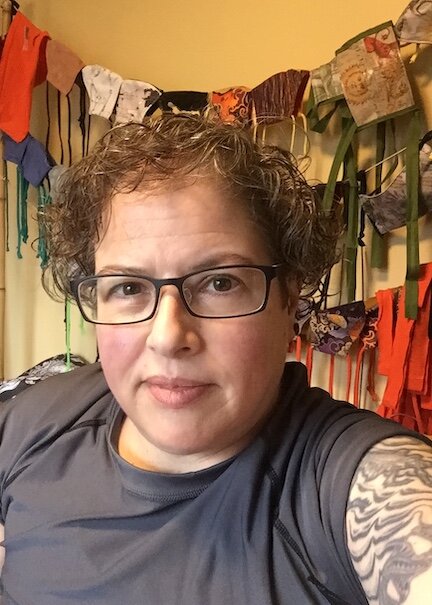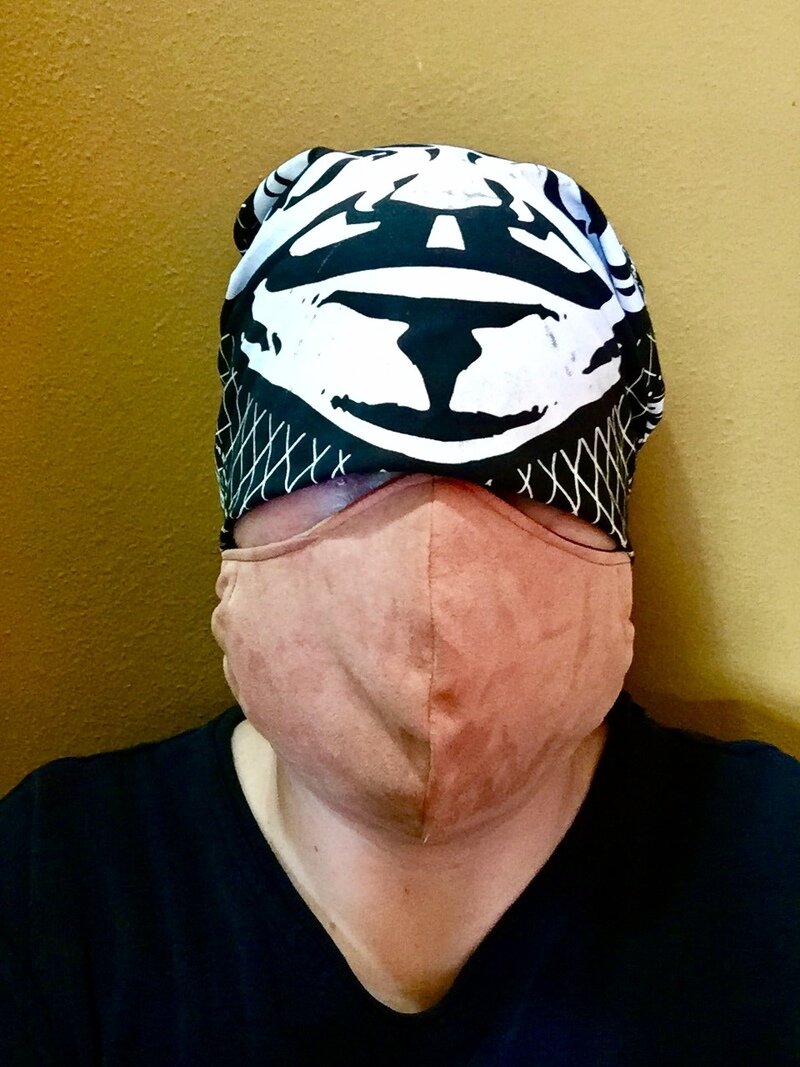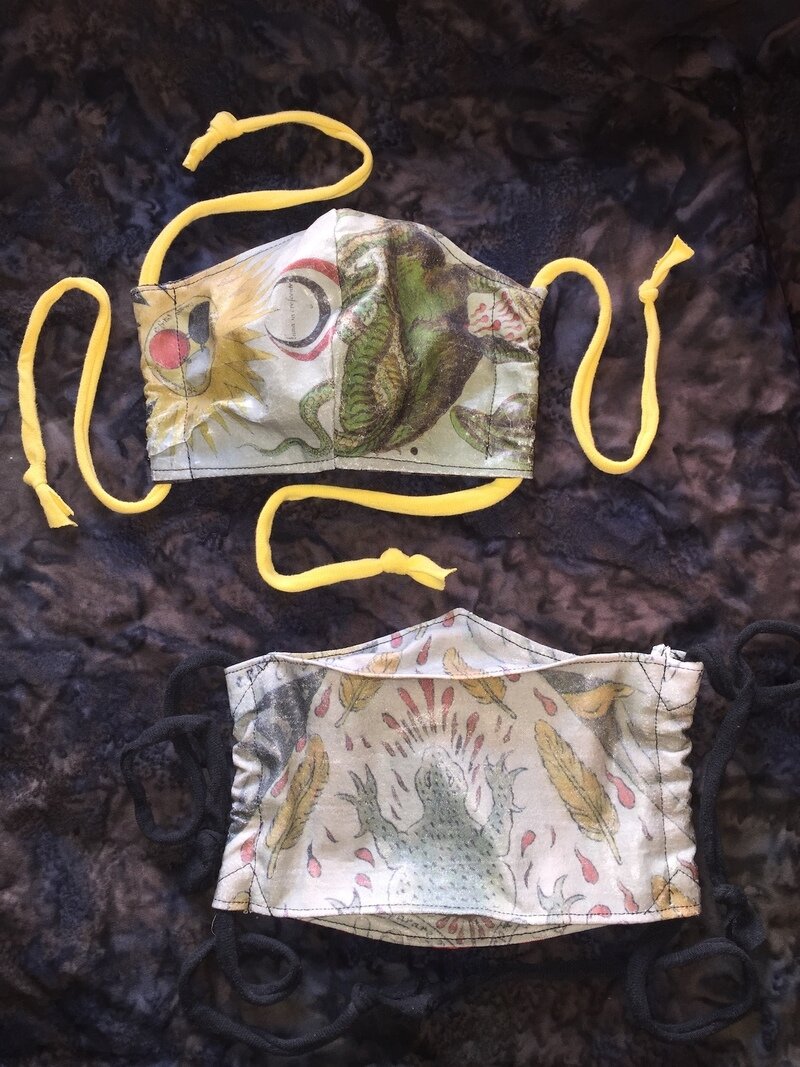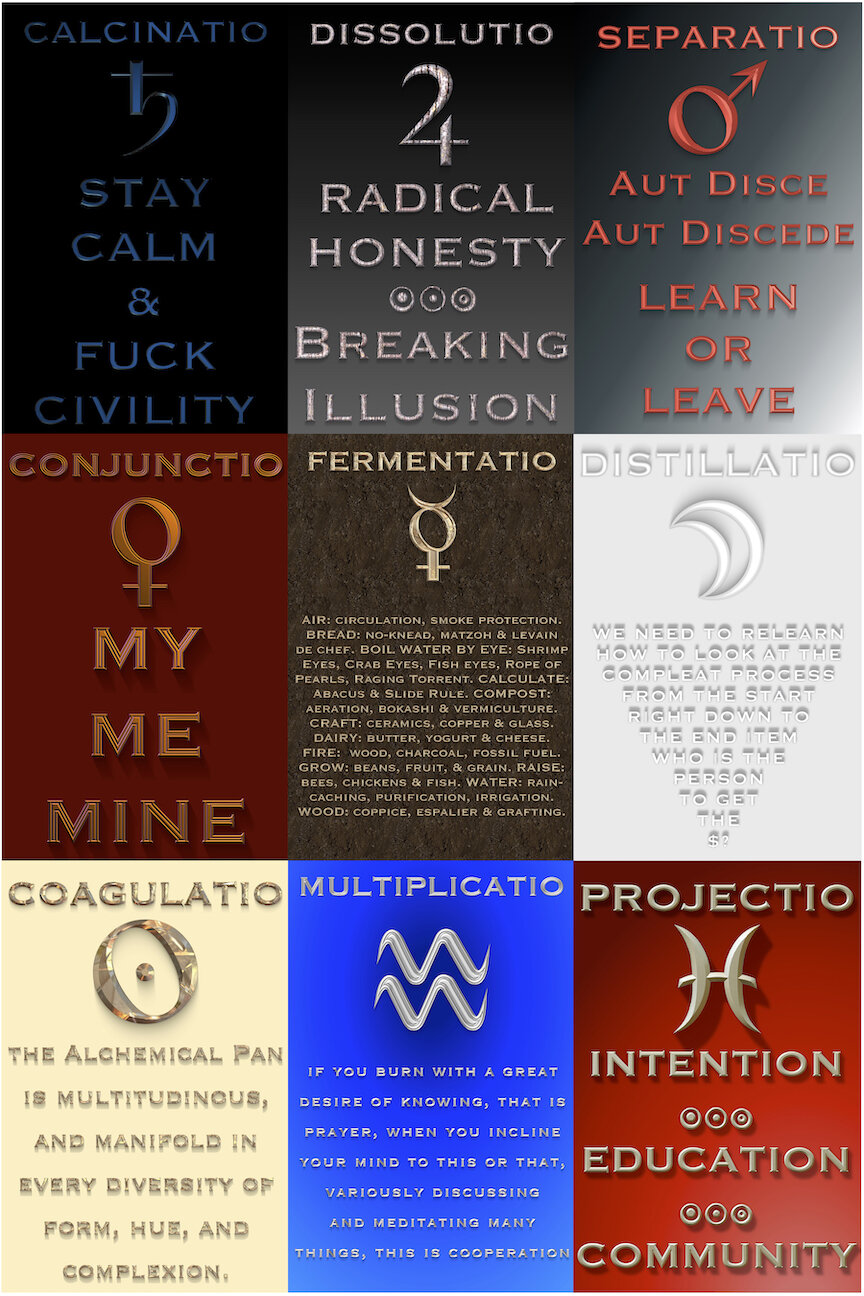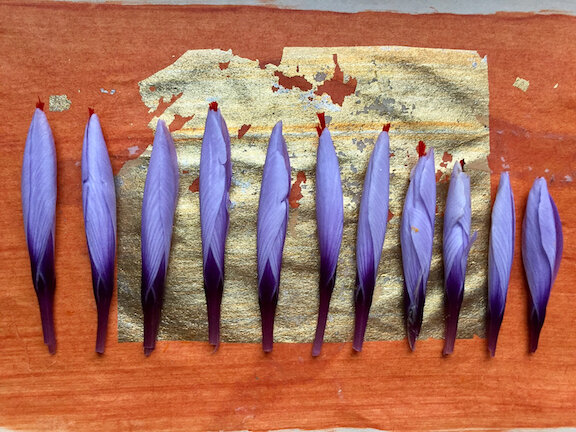raye schwarz
Blood on Their Faces (2020)
Found/on-hand materials of denim, cotton print, tassel fringe, cotton jersey. 9.5Wx5Hx1.5D (inches)
For purchase inquiries please contact the artist at tattooed.alchemist@gmail.com
To learn more about the artist visit https://masks.posthaven.com/
Artist’s statement
Presented here in 2120 is an antique trial mask, from the Blood On Their Faces movement of the 21st century. At the time, protestors would wear decorative, hand-sewn, red-themed masks in the galleries of televised trials. In the 2020s, the phrase “blood on their faces” was a popular protest slogan against the rise of fascist political practices of the day.
Visible below the forty-five red tassels is small scrap of white fabric with dark lines. It is unknown whether the symbol is meant to represent a mustache (the tassels symbolizing blood flowing over the patriarchy), or if it is a symbol of white men being put behind bars.
Masks such as these, whether of contemporary or original design, are still worn during World Mask Week, a holiday founded in 2020.
About the Artist
Raye Schwarz has a BA in Theater Arts from UC Santa Cruz and an MFA in Fashion Textiles from the Academy of Fine Art in San Francisco. They enjoy working with found objects and up-cycled materials for textile projects. A practitioner of alchemy and believer in the phrase “there are no coincidences in alchemy,” Raye was unsurprised to sew and trim the tassels and then count them, discovering that forty-five were left on the mask. Raye has presented at Mysterium in Las Vegas, PantheaCon in San Jose, Many Gods West in Olympia and the Magickal Women Conference in London.
.
Raye Schwarz was our featured artist for December 14-20, 2020.
In this interview they discuss their work in greater depth.
Raye Schwarz
Observation/Obfuscation by Raye Schwarz.
All rights reserved.
Observation/Obfuscation by Raye Schwarz.
All rights reserved.
Blood on Their Faces by Raye Schwarz.
All rights reserved.
Alchemical Imagery by Raye Schwarz. All rights reserved.
Saffron by Raye Schwarz. All rights reserved.
Work by Raye Schwarz. All rights reserved.
10 Questions
1) Your work Observation/Obfuscation considers the security and privacy problems of facial recognition technology. It also emphasizes that a mask can be designed to indicate privilege, particularly white privilege. Can you tell the story of this work and the inspiration behind it?
I currently live in Seattle, one of those American cities that has been protesting increasingly during the span of the Trump presidency, so wearing masks and black block (protecting identity for protest) was already a frequent sight before the pandemic. Then Seattle became the city where the coronavirus was first identified in the US. For the safety of my elderly parents here in town, for whom I am a caregiver, I began isolating and masking before the city and state called for a lockdown. To retreat from much of the world and still have a functioning household, and to feel that you have enough resources to stay that way, really comes down to white privilege.
Part of the mask came about through materials exploration. One of my self-imposed guidelines has been to primarily sew masks that can be washed and reused easily, whether than means tossing them in with regular laundry or hand-washing them in a sink. Synthetic ultra-suede can be hand- or machine-washed. Also, it’s dense, and creates a strong vapor barrier that prevents breath/moisture from passing through it. The scrap actually dates back decades. Part of what attracted me to it is that it’s almost exactly my skin tone. In costuming, it’s very easy to get fabrics or makeup to match skin tones on Caucasian performers, but difficult for anyone else, which is yet another demonstration of white privilege in modern culture.
2) You created work titled The Ripley Masks, which you based upon the Ripley Scrolls. Can you talk about what the Ripley Scrolls are – their significance and how they came into your life?
The Ripley Scrolls are copies of an original alchemical document named after Scottish alchemist George Ripley. As I was planning a trip to London in 2012, another copy of the scroll was found in the basement of the British Science Museum, only the 22nd or 23rd in existence. They showcased the scroll in an exhibition, so I was able to see that scroll during my trip. Since they allowed photography (something less commonly allowed in American museums) I took a ton of pictures. I just fell in love with the artwork and the fact that it wasn’t a finished work. I also viewed a different Ripley Scroll at the Wellcome Collection in 2019.
For this mask series, I began by playing with vintage iron-on paper, wanting to have a really fun mask for myself. From there the series slowly unfolds into different mask patterns featuring different parts of the images.
In laboratory alchemy, there are many shapes of glass vessels for condensing moisture and separating it again. Those transformations led me to consider how we use masks to condense our exhalations to separate the elements of Water and Air so the dross (unwanted part) can be removed from the whole. It’s the Solve without the Coagula.
I’m still exploring mask shapes and images from the Scrolls, and I expect to add a few more masks to that collection over the winter.
3) Can you share the trajectory of your art career and the unexpected twists and turns it has taken? Did you always want to be an artist?
My art has always been my avocation, not my vocation. Playing dress-up and pretend were my favorite childhood activities, and in a way, I never lost that as an adult. I wasn’t encouraged to be an artist during any of my primary or higher schooling because I don’t sketch or draw, and have never developed those skills. Most of my secondary education teachers told me I should be a writer. But I’ve been driven to create in the realm of dress-up my entire life. As a teen, I taught myself to paint on jackets and dye t-shirts, tracing designs when necessary. In college, the course offering of a mask-making class shifted my focus of study from film to theatrical costuming. Rather than leading the design team, I ran the costume crew and helped actors with their costumes and makeup. In graduate school, my focus was textile surface design, and I spent several years learning, as my studio mate once put it, “to turn white fabric into anything but.”
After school, I got a job at a clothing company and joined an art collective, which kept me playing with art and gave me a sales venue. That collective eventually closed, and for many years I only made art for friends. There was a period of over a decade where I participated in all-night fire circle events, and I started making special outfits and even building masks again for some of those occasions. When the pandemic first broke out in the United States, I started making masks for protection, but it quickly became apparent that my brain just didn’t have functional mask ideas, it also had artistic ones.
4) For The Babel Masks you created a work “Blood on their Faces” – a mask with a great deal of texture and pattern that imagines a future society where the protestors appear to gain a foothold: you describe a future in which this (2020) is the year where World Mask Week is initiated. Can you go a bit further into the future story and how a mask like this fits in?
When meditating on creating a future artifact, one question I asked myself was “how much of the original intention behind the crafting of an item manages to live along with it, if the item actually does manage to survive?” World Mask Week (https://www.globalcitizen.org/en/content/world-mask-week-wearamask-covid-19-pandemic/) was founded the week I finished sewing the tassels onto the mask.
Making the mask felt like a ritual. Wearing a mask daily is a ritual. Establishing a World Mask Week to promote mask-wearing to save lives is a ritual. Keeping up social engagement to maintain accountability in the wake of so many Coronavirus deaths in the United States is another ritual, and many more are to come. I made this mask to mark all of that. 100 years from now, the rituals and stories created in this time will be apparent on the faces of future generations.
5) You discuss the fact that you like to use up-cycled or second-hand materials in your work. Do you have friends or colleagues that typically pass on to you materials they think you might like to use, or do you like to seek out materials in certain places?
In the past, I’ve done a lot of both. Thrift/opportunity shops have definitely been a favorite, but they have not really been available to me this past year. I’ve been very socially isolated because my main job at this stage in my life is care-giving to my elderly parents. My mom gave me many lovely pieces of fabric this year — “to play with,” as she puts it — and they were the first family members I sewed masks for. I’ve been watching videos online on how to maintain and repair my grandmother’s 1946 Singer Featherweight, which is now my sewing machine. I love its economy of function. I have to figure out how to sew everything again, with the added limitation that I can only sew forwards and backwards in a straight line.
6) In your biography you mention that you are a practitioner of alchemy. Can you discuss the principles and practice of Alchemy a little bit, and can you discuss how that practice has impacted the direction of your work?
I was raised by an artist married to a chemist, so I always sensed a push-pull conflict between the two until I found Alchemy. No two alchemists have the same definition of Alchemy, and you will probably get three or four definitions from any one of them!
The more I study alchemy, the more it seems like a group of connected practices for examining and interpreting the world. The practitioner brings their own religion and beliefs, plugging these into the alchemical framework. I’ve done laboratory alchemy, reproducing experiments from the Medieval to the Victorian ages, to experience what earlier alchemists had done.
Alchemy has impacted my artistic practice: most importantly, it has really inverted the way I look at art and the way I think about how it communicates. In art school, if we were looking at a painting or photograph, a lot of time and energy was spent discussing the feelings viewers got when seeing it. The study of alchemical imagery, however, focuses more on the artist’s intention, on what they wanted to communicate. Alchemical imagery encodes and communicates alchemical knowledge and specific information to the future in a form that is incomprehensible to the casual viewer.
7) You also state, “there are no coincidences in Alchemy.” Would “serendipity” be another word for this phenomenon? Can you talk about one or two striking “coincidences” whose meaning was then clear to you?
I understand Alchemy as more of a belief that the workings of the Universe are designed for intentional conjunctions rather than accidental ones. It is like a complicated watch whose patterned gears create alignments. One recurring scenario in my life is finding myself in a situation with a stranger who feels strongly impelled to confess something to me that they have never told anyone. And when they tell me, I react not in any of the ways that they fear, but by offering genuinely useful advice about their situation. For another example, sometimes lost or confused strangers in public spaces ask me questions. As one acquaintance who has seen this more than once asked me, “Why do they always ask you? And how do you always have an answer?”
8) You hold an MFA in fashion textiles from the Academy of Fine Art in San Francisco, and a BFA in Theater Arts from UC Santa Cruz. Are these two disciplines and professions intertwined in your current practice, or does the earlier experience act as a secondary influence on the later one?
I’ve been doing gender consulting over the last two years, and it’s really brought back to me how much I still approach anything to do with clothing by asking, “who or what is this character?” Asking people how they would like to change how they are perceived, what emotions they feel when they wear certain garments, how they need to be able to move — it’s so much like working with an actor to build a character, but this time it isn't for the stage; it’s for daily life. My MFA allows me to fine-tune the skills I developed from the BFA.
9) What is your favorite aspect of working with textiles? Do you create patterns or prints yourself? Do you exclusively create masks?
My favorite aspect of textiles is texture, both physical and visual. I did make conventional fabric prints when I was in graduate school, but what always interested me more was the more abstracted end of fabric dyeing. I remember being the only person in my dyeing class in graduate school who knew what shibori was, and I was the only one to get excited that Ana Lisa Hedstrom was coming to give a guest lecture.
One of my most challenging and satisfying commissions was to create custom-dyed yardage for a wedding dress; the bride wanted silk fabric that looked like the texture of Birdseye maple, in purple. It was gorgeous, and it took two different sizes of salt to achieve that texture.
I don’t exclusively create masks, but I’ve made them more than any other art form - over about forty years, off-and-on. I’ve made them from leather, or feathers, or papier-mâché. I once had an elaborate mask collection. I have reduced what I collect, but I bet if I went through the entire house, a handful of them could still be found.
10) What advice would you have for a person just beginning to find themselves as an artist – what do you wish you had known when you started on that path?
Art is a lot more than what other people tell you it is, and the making of art is just as diverse. However you make art is valid. Capitalism will tell you endlessly that you have to turn your art into a business, but you can create art because it’s just what you love to do.

